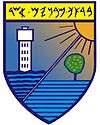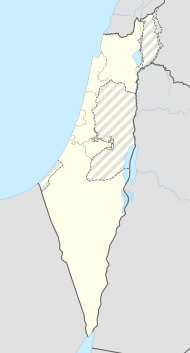Nahariya
| Nahariya | ||
|---|---|---|
|
||

|
||
| Basic data | ||
| hebrew : | נהריה | |
| arabic : | نهاريا | |
| State : |
|
|
| District : | North | |
| Coordinates : | 33 ° 0 ' N , 35 ° 6' E | |
| Height : | 15 m | |
| Area : | 10.233 km² | |
| Residents : | 56,881 (as of 2018) | |
| Population density : | 5,559 inhabitants per km² | |
| Community code : | 9100 | |
| Time zone : | UTC + 2 | |
| Community type: | city | |
| Website : | ||
|
|
||
Nahariiah ( Hebrew נהריה[naha'rija], Arabic نهاريا, DMG Nahārīyā ; Alternative spellings Nahariya , Nahariyya , Naharia ) is a city on the Mediterranean Sea north of Haifa in the northern district of Israel with 56,881 (2018) inhabitants.
history
Term of office
In ancient times there was already a Phoenician port on the site of Nahariyas , but today's city was only founded in 1934 by Jewish immigrants from Germany and was initially an agricultural settlement of privately-run farmers ( Moschawa ). The founders included the investor Joseph Loewy (1885–1949), the agronomist Selig Eugen Soskin (1873–1959), the banker Heinrich Cohn (1895–1976) and the engineer Simon Reich (1883–1941). Initially, around 100 families who had fled the increasing discrimination and persecution in Nazi Germany between 1933 and 1939 settled in Nahariya. Many craftsmen from Central Europe and workers from Eastern Europe joined them, so that the settlement had around 1000 inhabitants by the start of the war in 1939. Agriculture was no longer sufficient as a food source. Early on, individual settlers began to set up small hotels to accommodate those looking for relaxation. In the course of time, small businesses became large companies in the food industry, such as the Strauss dairy or the Soglowek butchery . Stef Wertheimer's handicraft business from Kippenheim developed into Israel's largest industrial company. “Naharija glass” by Andreas Meyer (1921–2016) from Rheda in Westphalia also became world famous .
Nahariya was a center of German-speaking culture in Israel in the first decades of its existence. The importance of German-speaking authors such as Erich Bloch (1897–1994) from Konstanz, Jenny Cramer (1887–1975) from Stuttgart or Fritz Wolf (1908–2006) from Heilbronn has only recently been recognized after everything is German in Israel had been frowned upon for a long time. The Museum of German-speaking Judaism , founded by Yisrael Shiloni (Hans Herbert Hammerstein, * 1901 in Berlin - † 1996) in Nahariya, continues today in the nearby industrial park Tefen.
After the founding of the state
For a long time the place was the only Jewish settlement in the coastal plain north of Akko and was isolated. Because of this, Nahariya was cut off from the outside world during the Israeli War of Independence in 1948 and could only be supplied by boats across the sea.
On April 22, 1979, Nahariya was the target of an attack by the Palestinian Liberation Front , whose leader was Samir Kuntar . A family man and his two daughters were killed in the attack at the age of two and four. During the attack, the terrorists also killed two police officers. The next day, Abu Abbas is said to have declared from Beirut that the attack in Nahariya was carried out to protest the signing of the Egyptian-Israeli peace treaty that followed the summit between Anwar as-Sadat and Menachem, which was brokered by US President Jimmy Carter Begin at Camp David in March 1979.
In the 21st century
On September 9, 2001, a Palestinian suicide bomber killed three Israelis and injured at least 46, some seriously, at Nahariya train station .
During the 2006 Lebanon War , Hezbollah shot at Nahariya with rockets. In January 2009, Nahariya was again hit by some rockets during the Gaza War. Hezbollah denied involvement, arguing that militant Palestinian autonomous groups in Lebanon were responsible.
Today Nahariya is a popular seaside resort. The city center lies on the Ga'aton river , which is canalised in the city and is lined by an avenue. The nearby chalk cliffs of Rosh HaNikra on the Lebanese border and the city of Akko a few kilometers south are of particular tourist interest in the area .
The German historian Klaus Kreppel is a recognized Nahariy expert, whose publications are referred to in the bibliography.
Partnerships
Town twinning
-
 Liberec , Czech Republic
Liberec , Czech Republic -
 Alzey, Rhineland-Palatinate
Alzey, Rhineland-Palatinate
-
 Darmstadt, Hesse
Darmstadt, Hesse
-
 Paderborn, North Rhine-Westphalia
Paderborn, North Rhine-Westphalia
-
 Tempelhof-Schöneberg district , Berlin , Germany, since 1970
Tempelhof-Schöneberg district , Berlin , Germany, since 1970 -
 Bielefeld , Germany, since 1980
Bielefeld , Germany, since 1980 -
 Issy-les-Moulineaux , France
Issy-les-Moulineaux , France -
 Miami Beach , USA
Miami Beach , USA -
 Delray Beach, Florida , USA
Delray Beach, Florida , USA -
 Kecskemét, Bács-Kiskun , Hungary
Kecskemét, Bács-Kiskun , Hungary
City friendship
-
 Offenbach am Main , Germany, since 1978
Offenbach am Main , Germany, since 1978
School partnership
-
 Welfen grammar school and grammar school Weingarten with the Amal Comprehensive School Nahariya since 1991
Welfen grammar school and grammar school Weingarten with the Amal Comprehensive School Nahariya since 1991
-
 Heepen high school in Bielefeld with Amal school in Naharija, since 1988
Heepen high school in Bielefeld with Amal school in Naharija, since 1988
sons and daughters of the town
- Gai Assulin (* 1991), Israeli soccer player
- Gilad Schalit (* 1986), Israeli soldier
literature
- Klaus Kreppel: Paths to Israel. Conversations with German-speaking immigrants in Nahariya . Westfalen-Verlag, Bielefeld 1999, ISBN 3-88918-097-3 .
- Klaus Kreppel: Israel's hard-working Jeckes. Twelve business portraits of German-speaking Jews in Nahariya . Westfalen-Verlag, Bielefeld 2002, ISBN 3-88918-101-5 .
- Klaus Kreppel: Nahariyya - the village of the "Jeckes". The establishment of the middle class settlement for German immigrants in Eretz Israel in 1934/35 . The Open Museum, Tefen 2005, ISBN 965-7301-01-7 .
- Klaus Kreppel: Nahariya's Early Years 1934–1949 The historical introduction and the prefaces to the 15 categories were written by the historian Dr. Klaus Kreppel from Bielefeld . ( rutkin.info ).
- Klaus Kreppel: Nahariyya and the German immigration to Eretz Israel. The history of its inhabitants from 1935 to 1941 . The Open Museum, Tefen 2010, ISBN 978-965-7301-26-5 .
- Klaus Kreppel: Nahariyya Moshewet haYekkim. Sippur Dor HaMeyassdim 1935-1941 . The Open Museum, Tefen 2011, ISBN 978-965-7301-32-6 .
Web links
supporting documents
- ↑ אוכלוסייה ביישובים 2018 (population of the settlements 2018). (XLSX; 0.13 MB) Israel Central Bureau of Statistics , August 25, 2019, accessed May 11, 2020 .
- ↑ אוכלוסייה ביישובים 2018 (population of the settlements 2018). (XLSX; 0.13 MB) Israel Central Bureau of Statistics , August 25, 2019, accessed May 11, 2020 .
- ^ Sophie Buchholz: Hans Herbert Hammerstein / Yisrael Shiloni. An educational biography , master's thesis, Berlin, 2008
- ↑ Four dead and 46 injured in a suicide attack in Israel In: Kölner Stadt-Anzeiger .de, September 9, 2001, accessed on August 2, 2018.
- ↑ Michael Neuberger: Nahariya: House for House. In: MB Yakinton. Tel Aviv January 2011. Vol. 79, No. 244, pp. 13-14. Also: Michael (Mucky) Neuberger: Nahariya: House by House. In: irgun-jeckes.org. Archived from the original on January 23, 2015 ; accessed on January 23, 2015 .
- ↑ Offenbach and its twin cities. From: offenbach.de , accessed on April 29, 2016.


